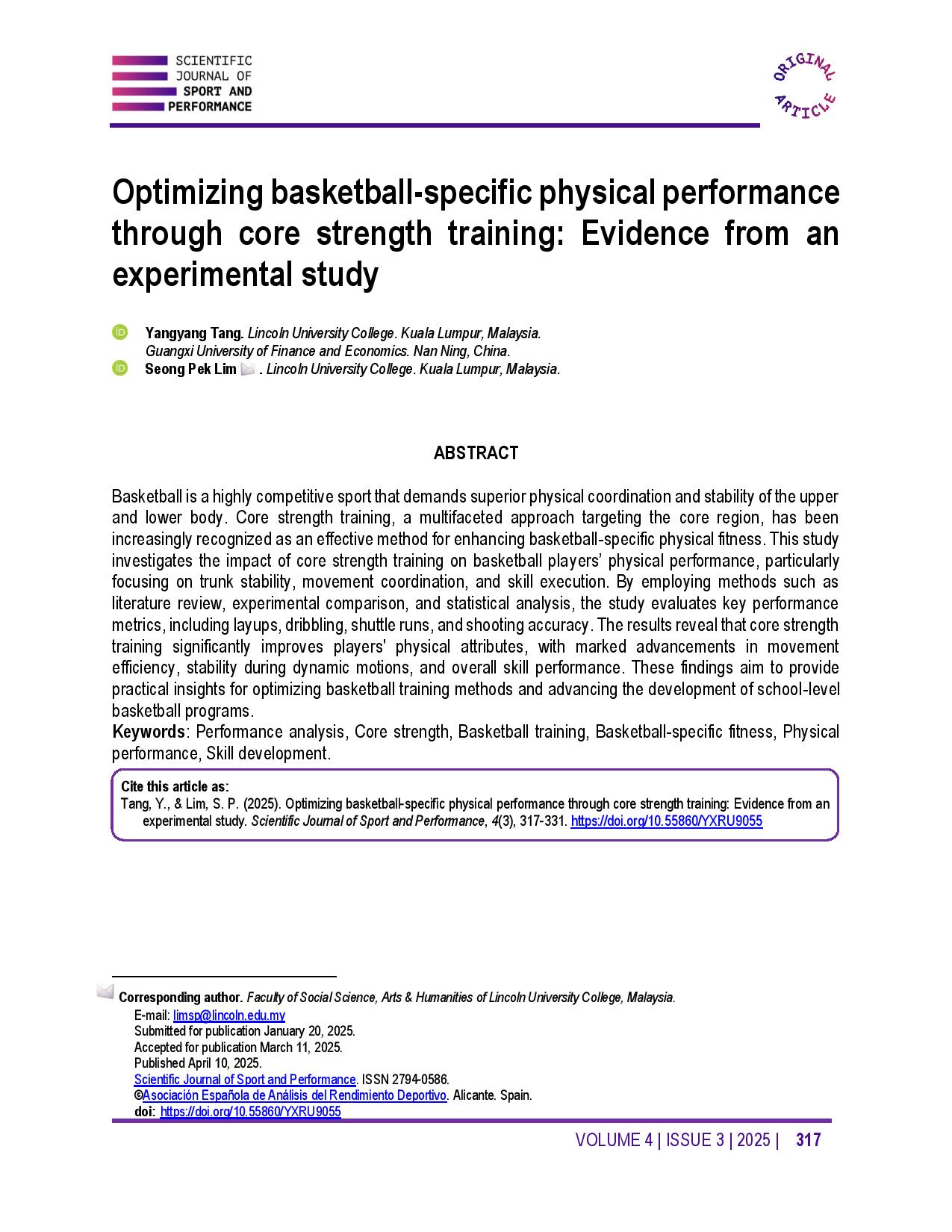Optimizing basketball-specific physical performance through core strength training Evidence from an experimental study
Main Article Content
Abstract
Basketball is a highly competitive sport that demands superior physical coordination and stability of the upper and lower body. Core strength training, a multifaceted approach targeting the core region, has been increasingly recognized as an effective method for enhancing basketball-specific physical fitness. This study investigates the impact of core strength training on basketball players’ physical performance, particularly focusing on trunk stability, movement coordination, and skill execution. By employing methods such as literature review, experimental comparison, and statistical analysis, the study evaluates key performance metrics, including layups, dribbling, shuttle runs, and shooting accuracy. The results reveal that core strength training significantly improves players' physical attributes, with marked advancements in movement efficiency, stability during dynamic motions, and overall skill performance. These findings aim to provide practical insights for optimizing basketball training methods and advancing the development of school-level basketball programs.
Article Details

This work is licensed under a Creative Commons Attribution-NonCommercial-ShareAlike 4.0 International License.
References
Arora, C., Singh, P., & Varghese, V. (2021). Biomechanics of core musculature on upper extremity performance in basketball players. Journal of bodywork and movement therapies, 27, 127-133. https://doi.org/10.1016/j.jbmt.2021.02.023 DOI: https://doi.org/10.1016/j.jbmt.2021.02.023
Borghuis, J., Hof, A. L., & Lemmink, K. A. (2008). The importance of sensory-motor control in providing core stability: implications for measurement and training. Sports medicine, 38, 893-916. https://doi.org/10.2165/00007256-200838110-00002 DOI: https://doi.org/10.2165/00007256-200838110-00002
Feng, Z. (2009). Application of Core Strength Training in Basketball Training in Tianjin Colleges and Universities Beijing Sports University].
Hassan, A. K., Bursais, A. K., Alibrahim, M. S., Selim, H. S., Abdelwahab, A. M., & Hammad, B. E. (2023). The impact of core complex training on some basketball-related aspects of physical strength and shooting performance. European Journal of Investigation in Health, Psychology and Education, 13(9), 1624-1644. https://doi.org/10.3390/ejihpe13090118 DOI: https://doi.org/10.3390/ejihpe13090118
Hibbs, A. E., Thompson, K. G., French, D., Wrigley, A., & Spears, I. (2008). Optimizing performance by improving core stability and core strength. Sports medicine, 38, 995-1008. https://doi.org/10.2165/00007256-200838120-00004 DOI: https://doi.org/10.2165/00007256-200838120-00004
Hodges, P. W., & Richardson, C. A. (1996). Inefficient muscular stabilization of the lumbar spine associated with low back pain: a motor control evaluation of transversus abdominis. Spine, 21(22), 2640-2650. https://doi.org/10.1097/00007632-199611150-00014 DOI: https://doi.org/10.1097/00007632-199611150-00014
Hsu, S.-L., Oda, H., Shirahata, S., Watanabe, M., & Sasaki, M. (2018). Effects of core strength training on core stability. Journal of physical therapy science, 30(8), 1014-1018. https://doi.org/10.1589/jpts.30.1014 DOI: https://doi.org/10.1589/jpts.30.1014
Huxel Bliven, K. C., & Anderson, B. E. (2013). Core stability training for injury prevention. Sports health, 5(6), 514-522. https://doi.org/10.1177/1941738113481200 DOI: https://doi.org/10.1177/1941738113481200
Isacowitz, R., & Clippinger, K. (2019). Pilates anatomy. Human Kinetics.
Jeong, J., Choi, D.-H., & Shin, C. S. (2021). Core strength training can alter neuromuscular and biomechanical risk factors for anterior cruciate ligament injury. The American journal of sports medicine, 49(1), 183-192. https://doi.org/10.1177/0363546520972990 DOI: https://doi.org/10.1177/0363546520972990
Liu, Y. (2022). A Study on the Importance of Core Strength and Coordination Balance during Basketball Based on Biomechanics. Molecular & Cellular Biomechanics, 19(3). https://doi.org/10.32604/mcb.2022.019342 DOI: https://doi.org/10.32604/mcb.2022.019342
McGill, S. (2015). Low back disorders: evidence-based prevention and rehabilitation. Human Kinetics.
McGill, S. M., Andersen, J. T., & Horne, A. D. (2012). Predicting performance and injury resilience from movement quality and fitness scores in a basketball team over 2 years. The Journal of Strength & Conditioning Research, 26(7), 1731-1739. https://doi.org/10.1519/JSC.0b013e3182576a76 DOI: https://doi.org/10.1519/JSC.0b013e3182576a76
Okada, T., Huxel, K. C., & Nesser, T. W. (2011). Relationship between core stability, functional movement, and performance. The Journal of Strength & Conditioning Research, 25(1), 252-261. https://doi.org/10.1519/JSC.0b013e3181b22b3e DOI: https://doi.org/10.1519/JSC.0b013e3181b22b3e
Ozmen, T., & Aydogmus, M. (2016). Effect of core strength training on dynamic balance and agility in adolescent badminton players. Journal of bodywork and movement therapies, 20(3), 565-570. https://doi.org/10.1016/j.jbmt.2015.12.006 DOI: https://doi.org/10.1016/j.jbmt.2015.12.006
Peate, W., Bates, G., Lunda, K., Francis, S., & Bellamy, K. (2007). Core strength: a new model for injury prediction and prevention. Journal of occupational medicine and toxicology, 2, 1-9. https://doi.org/10.1186/1745-6673-2-3 DOI: https://doi.org/10.1186/1745-6673-2-3
Prieske, O., Mühlbauer, T., Borde, R. a., Gube, M., Bruhn, S., Behm, D. G., & Granacher, U. (2016). Neuromuscular and athletic performance following core strength training in elite youth soccer: Role of instability. Scandinavian journal of medicine & science in sports, 26(1), 48-56. https://doi.org/10.1111/sms.12403 DOI: https://doi.org/10.1111/sms.12403
Şahiner, V., & Koca, F. (2021). Investigation of the effect of 8 weeks core training program on free shooting and vertical jump performance in basketball players aged 16-18. European Journal of Physical Education and Sport Science, 7(2). https://doi.org/10.46827/ejpe.v7i2.3882 DOI: https://doi.org/10.46827/ejpe.v7i2.3882
Shinkle, J., Nesser, T. W., Demchak, T. J., & McMannus, D. M. (2012). Effect of core strength on the measure of power in the extremities. The Journal of Strength & Conditioning Research, 26(2), 373-380. https://doi.org/10.1519/JSC.0b013e31822600e5 DOI: https://doi.org/10.1519/JSC.0b013e31822600e5
Tang, Y., & Lim, S. P. (2025). Mental training for college athletes: A comparative analysis of Chinese and Western approaches and innovations. Journal of Human Sport and Exercise, 20(1), 266-279. https://doi.org/10.55860/5rvacy38 DOI: https://doi.org/10.55860/5rvacy38
Wood, S. (2019). Pilates for rehabilitation. Human Kinetics. https://doi.org/10.5040/9781718209572 DOI: https://doi.org/10.5040/9781718209572
Zemková, E., & Zapletalová, L. (2022). The role of neuromuscular control of postural and core stability in functional movement and athlete performance. Frontiers in Physiology, 13, 796097. https://doi.org/10.3389/fphys.2022.796097 DOI: https://doi.org/10.3389/fphys.2022.796097




